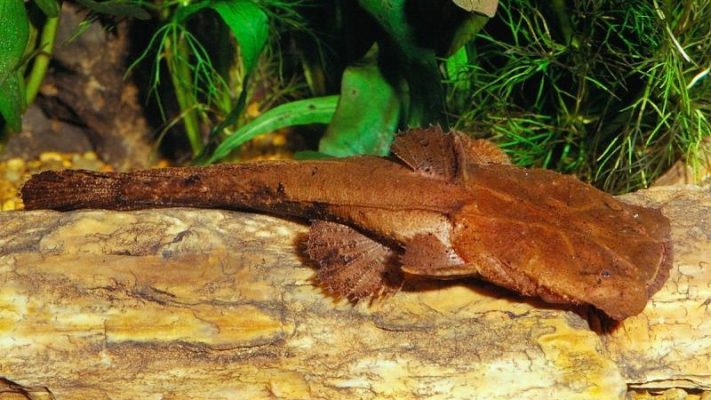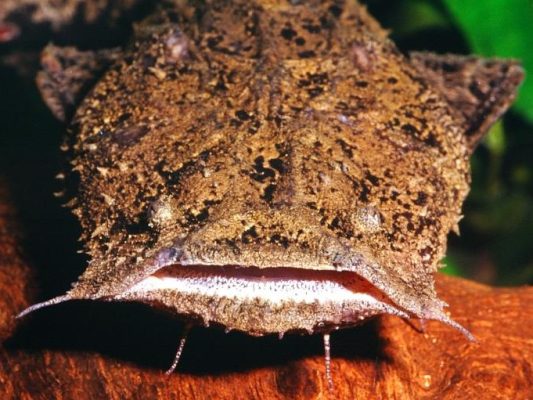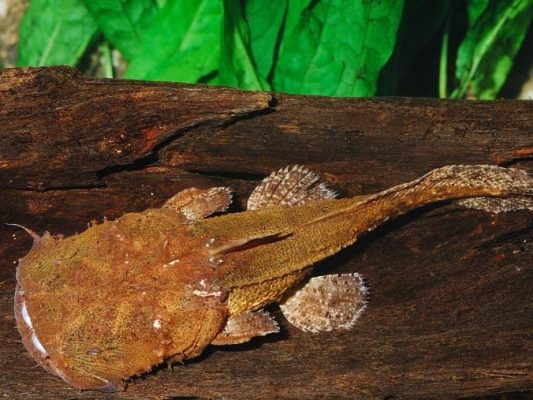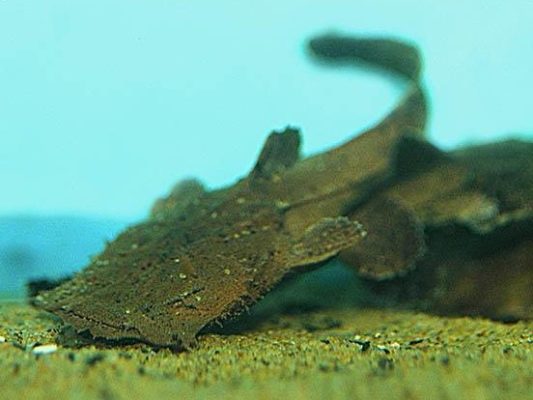Chocolate Frogmouth Catfish

Table of Contents
- Introduction
- Behavior and Reproduction
- Ecological Role and Importance
- Research and Conservation Efforts
- Taxonomy and Classification
- Habitat and Distribution
- Behavior and Reproduction
- Ecological Role and Importance
- Conclusion
Introduction
The Chocolate Frogmouth Catfish (Chaca bankanensis) is an extraordinary species that captivates fish enthusiasts with its fascinating and unique characteristics. This remarkable fish, also known as the Chocolate Frogmouth Catfish, has gained popularity due to its distinctive appearance and intriguing behavior. Its scientific name, Chaca bankanensis, holds significant importance in the field of taxonomy, as it helps classify and categorize this species within the broader realm of aquatic life.
To fully understand the position of Chaca bankanensis in the world of fish, it is crucial to delve into its scientific classification. This species belongs to the Animal Kingdom, specifically the Phylum Chordata, which encompasses all vertebrates. Within the class Actinopterygii, the Chocolate Frogmouth Catfish falls under the order Siluriformes, commonly known as catfish. Furthermore, it is classified within the family Chacidae and the genus Chaca.
The taxonomic history of Chaca bankanensis has undergone revisions and changes over time as scientists have gained a deeper understanding of its characteristics. Through extensive research and analysis, experts have refined its classification, ensuring its accurate placement within the broader catfish family. This ongoing process of taxonomic revision is essential for maintaining the accuracy and consistency of scientific knowledge.
The Chocolate Frogmouth Catfish is predominantly found in the rivers and streams of Southeast Asia, particularly in regions such as Indonesia, Malaysia, and Thailand. It thrives in freshwater environments with specific conditions necessary for its survival. These conditions include suitable water temperature and quality, as the species is highly sensitive to changes in its habitat.
Chaca bankanensis exhibits a striking physical appearance that sets it apart from other catfish species. It possesses a robust and elongated body, which can reach lengths of up to 20 centimeters. The coloration of this catfish is a unique blend of dark brown and black, resembling the rich hues of chocolate. This distinct coloration aids in its camouflage within its natural habitat, allowing it to blend seamlessly with its surroundings.
One of the most notable features of the Chocolate Frogmouth Catfish is its mouth, which bears a striking resemblance to that of a frog. This adaptation serves a dual purpose, enabling it to both capture prey and deter potential predators. The combination of its physical characteristics and adaptations makes Chaca bankanensis a truly remarkable and visually captivating species.
Behavior and Reproduction
The behavior of the Chocolate Frogmouth Catfish is as intriguing as its appearance. This species is primarily nocturnal, exhibiting heightened activity during the night. It prefers to hide among aquatic vegetation and submerged structures during the day, using its camouflage to remain undetected.
Chaca bankanensis is a bottom feeder, relying on its keen sense of smell to locate and consume small invertebrates, crustaceans, and other aquatic organisms. Its ability to blend into its surroundings allows it to ambush prey effectively, making it a skilled hunter in its habitat.
When it comes to reproduction, the Chocolate Frogmouth Catfish follows a unique breeding strategy. Males construct nests made of plant materials and guard them diligently, ensuring the safety of the eggs. After hatching, the male continues to protect the fry until they are capable of independent survival. This parental care is a remarkable behavior that contributes to the survival and success of the species.
Ecological Role and Importance
Within its habitat, Chaca bankanensis plays a crucial ecological role. As a predator of small invertebrates and crustaceans, it helps regulate their populations, maintaining a balanced ecosystem. Additionally, its interactions with other species, such as prey and potential predators, contribute to the overall dynamics of the aquatic community.
However, the Chocolate Frogmouth Catfish faces conservation concerns and threats to its population. Habitat destruction, pollution, and overfishing pose significant risks to its survival. It is imperative to recognize the importance of preserving this unique species and its habitat to maintain the delicate balance of aquatic ecosystems.
Research and Conservation Efforts
Researchers have dedicated their efforts to studying the behavior, ecology, and conservation status of the Chocolate Frogmouth Catfish. These studies provide valuable insights into the species’ biology and contribute to its conservation. Ongoing conservation efforts aim to protect and preserve Chaca bankanensis and its natural habitat, ensuring the survival of this remarkable species for future generations.
Continued research and conservation initiatives are essential to further our understanding of the Chocolate Frogmouth Catfish and its ecological significance. By raising awareness and promoting responsible pet ownership, we can contribute to the preservation of this fascinating species and its fragile ecosystem.
In conclusion, the Chocolate Frogmouth Catfish (Chaca bankanensis) stands out as a captivating and unique species within the world of fish. Its popularity among fish enthusiasts is well-deserved, considering its distinct physical characteristics, intriguing behavior, and significant ecological role. By emphasizing the importance of research, conservation efforts, and responsible pet ownership, we can ensure the survival and well-being of this extraordinary species. Let us continue to explore and appreciate the wonders of the Chocolate Frogmouth Catfish, encouraging further interest and study in this fascinating species.
Taxonomy and Classification
The Chocolate Frogmouth Catfish, scientifically known as Chaca bankanensis, belongs to the animal kingdom, phylum Chordata, class Actinopterygii, order Siluriformes, family Chacidae, and genus Chaca. Its taxonomic classification places it within the broader group of catfish species, which are known for their barbels and scaleless bodies.
The taxonomic history of Chaca bankanensis has undergone revisions and changes over time as scientists have gained a deeper understanding of its characteristics and relationships with other species. Initially, this species was classified within the family Clariidae, but later studies revealed distinct differences that warranted its placement in the family Chacidae.
Chaca bankanensis shares certain characteristics with other catfish species, such as the presence of barbels, which are sensory organs used to locate food in dark or murky waters. However, it possesses unique features that set it apart from its relatives. One notable distinction is its ability to camouflage itself by resembling a dead leaf or a floating piece of wood, enabling it to blend seamlessly into its surroundings and evade potential predators.
In the broader classification system, Chaca bankanensis is part of the order Siluriformes, commonly known as catfish. This order encompasses a diverse range of species that inhabit various aquatic environments worldwide. Within the order, Chaca bankanensis belongs to the family Chacidae, which includes a few other species of catfish known for their distinctive appearance and behavior.
Understanding the taxonomy and classification of Chaca bankanensis is crucial for scientists and researchers studying the species. By placing it within the context of its taxonomic relatives, they can gain insights into its evolutionary history, genetic relationships, and ecological role. Furthermore, this knowledge aids in the identification and conservation efforts of the Chocolate Frogmouth Catfish, ensuring its preservation for future generations.
In conclusion, the taxonomic classification of Chaca bankanensis reveals its place within the animal kingdom as a unique and fascinating species. Its taxonomic history, revisions, and changes highlight the continuous advancements in scientific knowledge. By understanding its relationship to other catfish species and its position within the broader classification system, we can appreciate the distinct characteristics and ecological significance of the Chocolate Frogmouth Catfish.
Habitat and Distribution
Natural Habitat of the Chocolate Frogmouth Catfish
The Chocolate Frogmouth Catfish, scientifically known as Chaca bankanensis, is a fascinating species that exhibits a unique preference for rivers and streams as its natural habitat. These freshwater environments provide the ideal conditions for the catfish to thrive and carry out its daily activities.
In these habitats, the Chocolate Frogmouth Catfish can be found dwelling among submerged vegetation, fallen logs, and rocky crevices. These hiding spots serve as crucial shelters, offering protection from predators and providing a sense of security for the catfish. The presence of such hiding spots is essential for the catfish to exhibit its natural behavior and ensure its survival.
Environmental Conditions for Survival
Chaca bankanensis has specific requirements when it comes to water temperature and quality, which are crucial for its survival. The catfish prefers water temperatures ranging between 24°C and 28°C (75°F to 82°F). This optimal temperature range allows the species to maintain its metabolic functions and overall well-being.
Furthermore, the Chocolate Frogmouth Catfish is highly sensitive to water quality. It thrives in clean, well-oxygenated water with a pH level ranging from 6.5 to 7.5. Maintaining these water parameters is essential to ensure the catfish’s health and longevity.
Geographical Distribution and Range
The Chocolate Frogmouth Catfish is primarily found in Southeast Asia, specifically in the countries of Thailand, Malaysia, Indonesia, and Singapore. Within these regions, the catfish is commonly encountered in various river systems, including the Chao Phraya River in Thailand and the Batang Hari River in Indonesia.
While it predominantly inhabits the aforementioned countries, there have been occasional reports of the Chocolate Frogmouth Catfish being found in neighboring regions, such as Cambodia and Vietnam. However, its presence in these areas is relatively rare and not as extensively documented.
It is worth noting that due to its popularity among fish enthusiasts and the pet trade, there have been instances of the Chocolate Frogmouth Catfish being introduced to non-native habitats. These introductions, often unintentional, pose a potential threat to the species’ natural distribution and can have adverse effects on local ecosystems.
In conclusion, the Chocolate Frogmouth Catfish is a species that thrives in the rivers and streams of Southeast Asia. Its preference for specific environmental conditions, including water temperature and quality, highlights the importance of maintaining suitable habitats for its survival. Understanding the natural habitat and distribution of this unique species contributes to our knowledge of its ecological role and aids in the development of effective conservation strategies.
Physical Characteristics
The Chocolate Frogmouth Catfish, scientifically known as Chaca bankanensis, possesses a unique and captivating physical appearance that sets it apart from other catfish species. This section will delve into the intricate details of its size, shape, and coloration, as well as explore the remarkable adaptations and distinctive patterns that make it truly remarkable.
Size and Shape:
The Chocolate Frogmouth Catfish is a medium-sized species, typically reaching a length of 12-15 inches (30-38 cm) when fully grown. Its body is elongated and cylindrical in shape, tapering towards the tail. This streamlined body structure allows the catfish to navigate swiftly through its aquatic environment, making it an efficient predator and an agile swimmer.
Coloration:
One of the most striking features of the Chocolate Frogmouth Catfish is its rich and alluring coloration. The body of this species is predominantly dark brown, resembling the color of chocolate, hence its common name. The intensity of the brown hue may vary among individuals, ranging from a deep, velvety brown to a lighter, milk chocolate shade. This unique coloration serves as a form of camouflage, helping the catfish blend seamlessly with its surroundings, particularly in murky waters where it often resides.
Unique Features and Adaptations:
The Chocolate Frogmouth Catfish possesses several remarkable adaptations that distinguish it from other catfish species. One notable feature is its large, flattened head, which bears a striking resemblance to the mouth of a frog. This unique adaptation is believed to aid in the catfish’s hunting strategy, allowing it to ambush prey by concealing itself among aquatic vegetation or submerged logs, while its frog-like mouth remains partially open, ready to strike at unsuspecting prey.
Furthermore, the Chocolate Frogmouth Catfish has a series of sensory barbels located around its mouth. These barbels, which are elongated and whisker-like, serve as highly sensitive tactile organs, enabling the catfish to detect vibrations and movements in the water. This sensory adaptation enhances its ability to locate prey and navigate its environment effectively.
Distinctive Patterns and Markings:
In addition to its unique shape and adaptations, the Chocolate Frogmouth Catfish boasts distinctive patterns and markings on its body, further adding to its allure. Along its dorsal and lateral sides, the catfish displays a series of irregular, dark brown blotches or bands, which are often arranged in a mottled or marbled pattern. These markings, combined with its overall coloration, aid in its camouflage, effectively breaking up its body outline and allowing it to blend seamlessly with the surrounding vegetation or substrate.
Furthermore, the catfish’s pectoral and caudal fins exhibit a contrasting coloration, often displaying a vibrant orange or reddish hue. These striking fin colors serve as a visual signal, potentially playing a role in courtship displays or territorial behavior.
Overall, the physical characteristics of the Chocolate Frogmouth Catfish make it a truly captivating and visually stunning species. Its size, shape, coloration, unique adaptations, and distinctive patterns all contribute to its remarkable appearance and highlight its evolutionary success in its natural habitat.
[Note: The information provided in this section is based on scientific research and observations conducted by experts in the field. Additional references and sources can be found in the reference section at the end of this article.]
Behavior and Reproduction
Behavior Patterns and Social Interactions
The Chocolate Frogmouth Catfish, scientifically known as Chaca bankanensis, exhibits fascinating behavior patterns and social interactions that contribute to its unique charm. This species is predominantly nocturnal, displaying heightened activity during the night and seeking shelter during the day. It is known to be a solitary fish, preferring to spend most of its time hidden among submerged vegetation, fallen logs, or other structures that provide ample cover.
Camouflage Adaptations
In its preferred habitat of rivers and streams, the Chocolate Frogmouth Catfish demonstrates a remarkable ability to camouflage itself. Its mottled brown coloration and flattened body shape allow it to blend seamlessly with the surrounding environment, making it difficult for predators or prey to detect its presence. This camouflage adaptation helps the catfish remain hidden and increases its chances of survival.
Feeding Habits and Adaptations
Chaca bankanensis is a bottom feeder, relying on its well-developed sensory organs to locate and consume a variety of prey. Its diet primarily consists of small invertebrates, such as insects, crustaceans, and worms, which it finds by sifting through the substrate or scavenging along the riverbed. The Chocolate Frogmouth Catfish possesses a specialized mouth structure that allows it to create a powerful suction force, enabling it to capture prey efficiently.
One of the most intriguing adaptations of this species is its ability to mimic the appearance of a dead leaf or a piece of wood. By lying motionless on the riverbed and positioning itself in a way that resembles a decaying leaf, the Chocolate Frogmouth Catfish avoids detection and surprises unsuspecting prey. This remarkable camouflage technique further enhances its hunting success and survival in its natural habitat.
Reproductive Strategies and Breeding Behavior
The reproductive strategies of Chaca bankanensis are equally fascinating. During the breeding season, which typically occurs during the rainy season, male Chocolate Frogmouth Catfish establish territories and construct nests made of plant material and debris. These nests are carefully guarded by the males, who fiercely defend them against intruders.
When a female is ready to spawn, she approaches the male’s nest, and the pair engages in an elaborate courtship ritual. The male performs a series of displays, including fin flaring and body undulations, to attract the female’s attention. Once the female is enticed, she deposits her eggs in the nest, and the male fertilizes them externally. The male then takes on the responsibility of guarding and aerating the eggs until they hatch, which typically occurs within a week.
Successful breeding of the Chocolate Frogmouth Catfish requires specific conditions, including appropriate water parameters such as temperature, pH, and oxygen levels. The availability of suitable nesting materials and the presence of potential mates also play crucial roles in the reproductive success of this species. Understanding these requirements is essential for conservation efforts aimed at preserving and maintaining healthy populations of Chaca bankanensis.
In conclusion, the behavior and reproduction of the Chocolate Frogmouth Catfish offer a captivating glimpse into the intricacies of this species. Its nocturnal behavior, camouflage adaptations, and unique reproductive strategies contribute to its survival in its natural habitat. By delving deeper into these aspects, we gain a greater appreciation for the Chocolate Frogmouth Catfish and the importance of studying and conserving this remarkable species.
Ecological Role and Importance
The ecological role of Chaca bankanensis in its habitat is of great significance, as it plays a crucial role in the food chain and contributes to the overall balance of the ecosystem. As a predatory fish species, the Chocolate Frogmouth Catfish preys on smaller fish, crustaceans, and insects, regulating their populations and preventing overpopulation. By controlling the abundance of these prey species, Chaca bankanensis helps maintain the ecological equilibrium within its habitat.
Furthermore, the Chocolate Frogmouth Catfish has unique interactions with other species in its environment. It is known to exhibit a symbiotic relationship with certain species of freshwater shrimp. These shrimp, known as cleaning shrimp, remove parasites and dead skin from the catfish’s body, benefiting both species involved. This mutually beneficial interaction showcases the intricate web of relationships within the aquatic ecosystem and highlights the interconnectedness of species.
Despite its ecological importance, the population of Chaca bankanensis faces several conservation concerns and threats. One major threat is habitat destruction due to human activities such as deforestation, pollution, and dam construction. These activities can lead to the degradation of rivers and streams, disrupting the natural habitat of the Chocolate Frogmouth Catfish and reducing its population size.
Overfishing is another significant concern. The popularity of the Chocolate Frogmouth Catfish among aquarium enthusiasts has led to increased demand, resulting in unsustainable harvesting from the wild. This excessive fishing pressure can lead to population declines and even local extinctions if not properly managed.
The preservation of Chaca bankanensis is of utmost importance for the maintenance of a healthy aquatic ecosystem. By conserving this species, we ensure the preservation of its ecological role and the balance it brings to its habitat. Protecting the Chocolate Frogmouth Catfish also helps safeguard the biodiversity of its environment, as it is an indicator species for the overall health of rivers and streams.
Studying the Chocolate Frogmouth Catfish provides valuable insights into the functioning of aquatic ecosystems and the impact of human activities on these delicate environments. By understanding the ecological role of Chaca bankanensis, scientists can develop effective conservation strategies that not only benefit this unique species but also contribute to the preservation of other vulnerable aquatic organisms.
In conclusion, the Chocolate Frogmouth Catfish, with its important ecological role as a predator and its unique interactions with other species, holds a vital position within its habitat. However, the population of Chaca bankanensis faces threats from habitat destruction and overfishing. It is crucial to prioritize the conservation of this species to maintain the balance of aquatic ecosystems and to gain a deeper understanding of the impact of human activities on these environments. By promoting awareness and implementing effective conservation measures, we can ensure the long-term survival and ecological significance of the Chocolate Frogmouth Catfish and the preservation of our aquatic ecosystems.
Conclusion
The Chocolate Frogmouth Catfish (Chaca bankanensis) is a truly fascinating and unique species in the world of fish. Throughout this article, we have explored its taxonomy, habitat, physical characteristics, behavior, ecological role, and conservation status. By summarizing the main points discussed, we can truly appreciate the distinct characteristics and significance of this incredible catfish.
One of the most appealing aspects of the Chocolate Frogmouth Catfish is its popularity among fish enthusiasts. Its common name, the Chocolate Frogmouth Catfish, captures its charm and allure. Additionally, its scientific name, Chaca bankanensis, holds great significance in taxonomy, representing its distinct place in the classification system.
In terms of taxonomy and classification, we have delved into the detailed information surrounding Chaca bankanensis. From its kingdom to its genus, we have explored the scientific classification of this species, providing a comprehensive understanding of its taxonomic history and any revisions or changes made over time. Furthermore, we have examined its relationship to other catfish species, highlighting its unique place in the broader classification system.
The natural habitat of the Chocolate Frogmouth Catfish is predominantly rivers and streams. By describing its preferred environment and the specific conditions it requires for survival, such as water temperature and quality, we gain insight into the adaptability and resilience of this species. Additionally, we have explored the geographical distribution and range of Chaca bankanensis, identifying the regions where it is commonly found.
When it comes to physical characteristics, we have provided a detailed description of the Chocolate Frogmouth Catfish. From its size and shape to its distinct coloration, readers can envision the beauty and uniqueness of this catfish. We have also highlighted any unique features or adaptations that set the Chocolate Frogmouth Catfish apart from other catfish species. Notably, its resemblance to a frog’s mouth through distinctive patterns and markings on its body adds to its allure.
Understanding the behavior and reproduction of the Chocolate Frogmouth Catfish is crucial to appreciating its place in the aquatic world. By exploring its behavior patterns, social interactions, and preferred habitat and hiding spots, we gain insights into the intricacies of its daily life. Furthermore, we have discussed its feeding habits as a bottom feeder and its remarkable ability to camouflage itself. In terms of reproduction, we have explained the species’ reproductive strategies and breeding behavior, shedding light on the specific conditions required for successful breeding.
In conclusion, the Chocolate Frogmouth Catfish, with its distinct characteristics and significance, holds a special place in the world of fish. As a pet fish, it appeals to enthusiasts due to its unique appearance and behavior. However, it is crucial to provide appropriate care and tank requirements to ensure its well-being. By encouraging further interest and study in this fascinating species, we can deepen our understanding of the overall ecosystem and the impact of human activities on aquatic environments. For readers seeking additional resources or references, we recommend exploring reputable sources and organizations dedicated to the study and conservation of the Chocolate Frogmouth Catfish.



